I am a Spanish/English carpenter with a keen interest in historical techniques and practices. I have taken courses in historic building methods and conservation with the Society for the Protection of Ancient Buildings, and the Weald and Downland in the UK, as well as a course in boatbuilding (mestre d’aixa) in Mallorca, where I come from. I’m also married to an art historian (Anna McSweeney, one of the co-investigators of the Crafting Medieval Spain project), so of course am now fascinated by the strapwork ceilings in Spain.

I realised how difficult these ceilings are to make when I built the puzzle based on the main design of the V&A’s Torrijos ceiling for the British Academy Summer Showcase in June 2022. The complex geometry involved in reproducing a section of the ceiling more or less exactly, but for the purpose of play and demonstration, led me to study the technique more closely. I read books by strapwork ceiling guru Enrique Nuere, spoke at length on the phone with specialist architect Javier de Mingo, and spent days and days drawing out the plans before finally cutting and finishing the puzzle. We were delighted with the result, but it was clear to me that I needed to go to Spain and learn from the masters!
In September 2022, the Consorcio de Toledo (a publicly-funded body for the restoration and rehabilitation of the historic centre of Toledo) ran a carpentry workshop for carpenters and those interested in learning the technique of carpintería de lo blanco, which is the technique used to build the Torrijos ceilings. I subscribed, along with around 20 others, and booked my flights and travel. The workshop was highly subsidised by the Consorcio, costing only €50 for the week, so the trip was not too costly for me – other than paying for travel and accommodation. This is the course brochure.
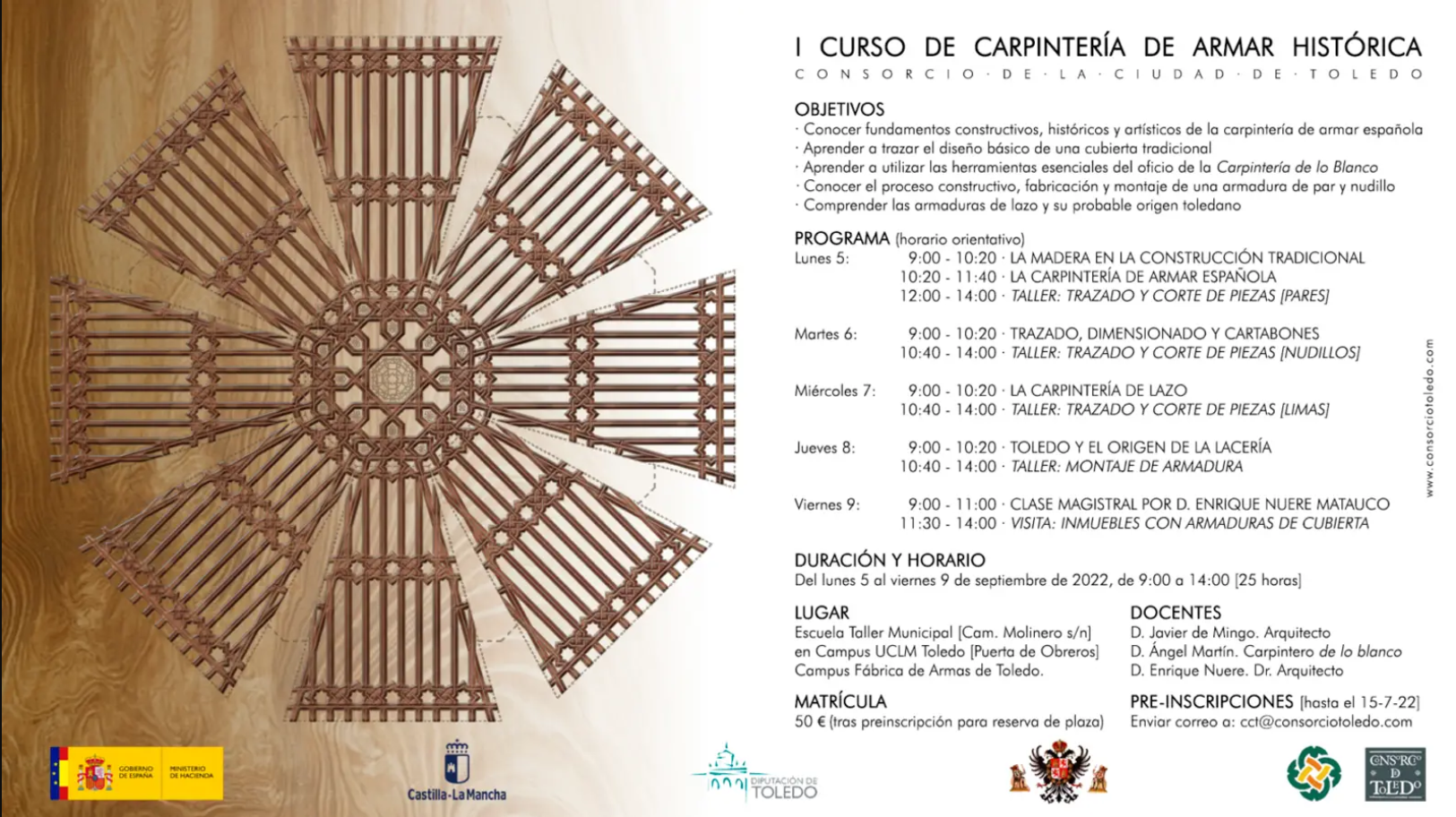
Day 1
I arrived at the Toledo campus of the Universidad de Castilla-La Mancha, which is now in the buildings of the old Arsenal and Armoury (la Fabrica de Armas) where I think they still teach blade making – there are lots of cabinets with amazing swords and knives, as this is a traditional craft from Toledo.
We were taken to the carpentry workshops (Escuela Taller Municipal) where there are still very old work benches, and were given a welcome talk by the director of the Consorcio de Toledo, Jesús Corroto. He told us that Pablo González Collado (who is the architect of the Consorcio de Toledo and the organiser of the course), was very excited to start back to work after his summer holidays because of what the week had in store for him!

We heard a talk about carpintería de lo blanco by Javier de Mingo, architect and expert in this technique. This was followed by a lecture on the theory of how to work out which cartabón (the name for the tool known also as the carpenter’s square) to use for a given roof space.
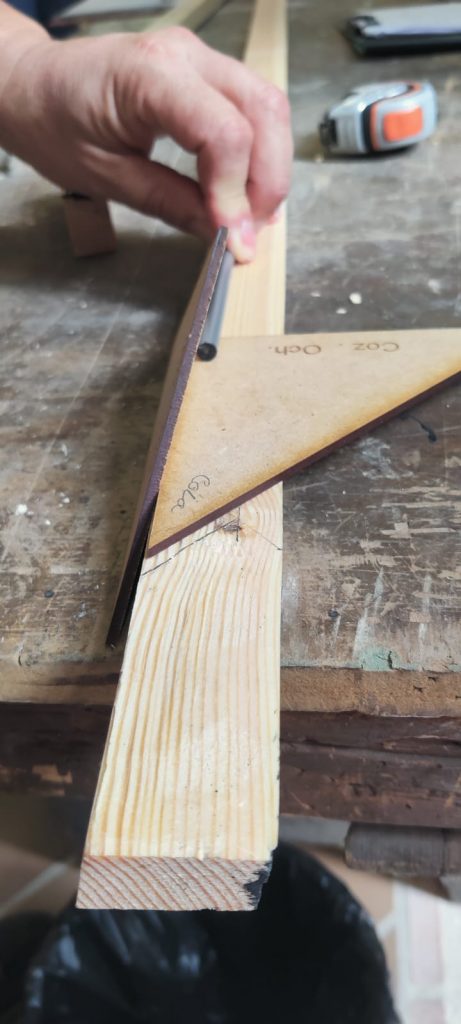
Which one you use depends on factors including the pitch of the roof, the pitch of the roof’s hip, and the relationship between them. In smaller groups we used the cartabones to mark out some pre-prepared pares (beams) and cut them to size, and to cut the garganta (part of a timber frame joint) for the nudillo (the mortice-type joint for the tie beam).
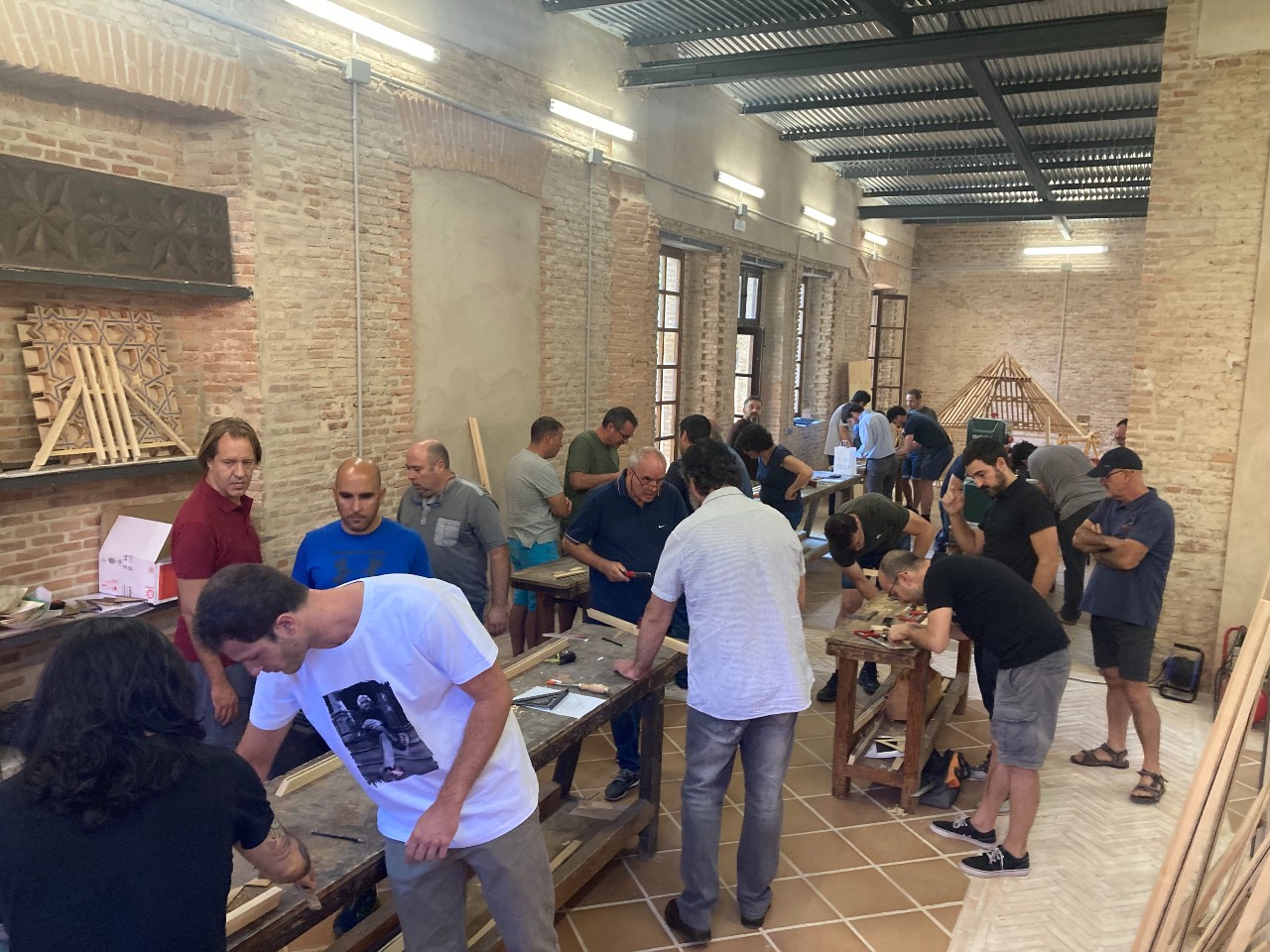
This was followed by a practical session with Ángel Martín on tools and techniques.
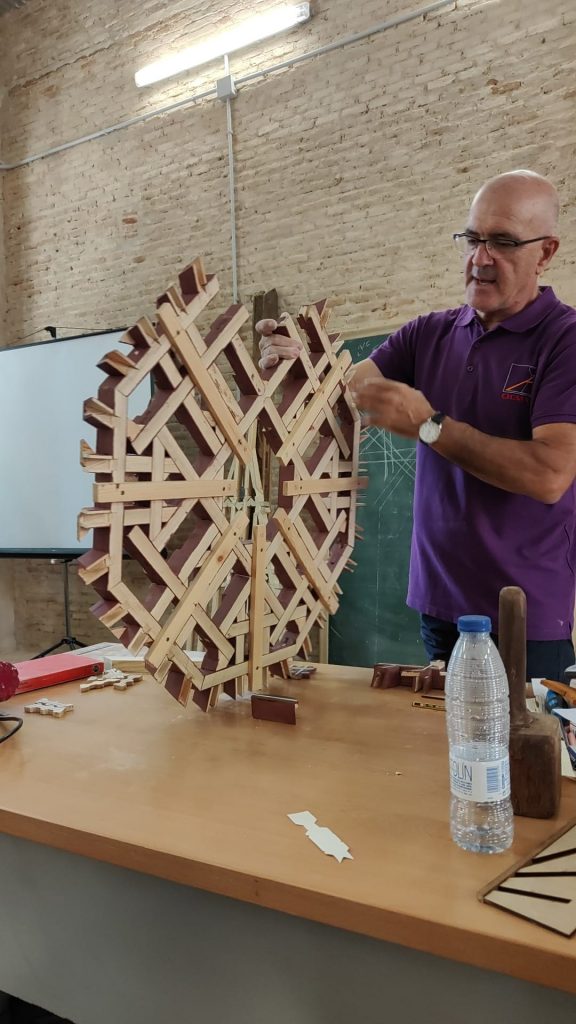
In the afternoon we met the technical architect from the Consorcio, Jose María Gutiérrez Arias, who took us into the Iglesia de San Justo where we saw a small roof that is rarely seen. We went up to see the structure from the top, climbing the bell tower through three inches of pigeon droppings – a real problem in these historic buildings! We climbed on to the structure of the main vaulted roof of the church to see the ceiling from above.
Day 2
The day started with a lovely continental breakfast in a room with glass floors showing Roman ruins, followed by a brisk 15-minute walk in the relatively cold 21 degrees to the university for a 9am start. Javier de Mingo gave a lecture on types of lacería (strapwork carpentry) and how to work out cartabones de lacería, followed by a lecture on how to lay out and mark up a beam requiring una rueda de ocho (an eight-sided star design) using three of the different cartabones – known as de cuatro, ocho and blanquillo. Ángel led the practical session during which we marked up our small beams and cut the joints.
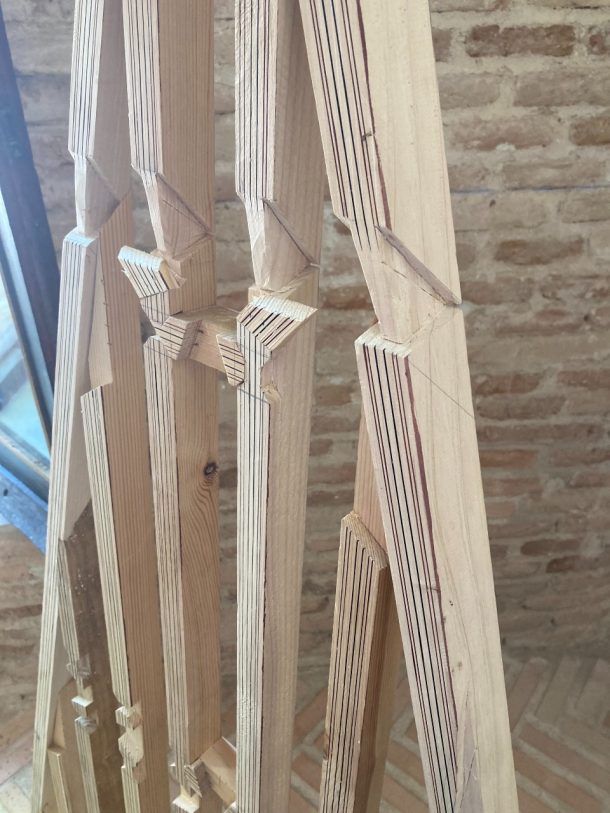
Lunch was in a local restaurant, La Virgen de la Estrella. We ate gazpacho, traditionally made in Toledo with a touch of cumin which the owner says takes away the repeating taste of the cucumber for the rest of the afternoon (it works!). This was followed by bacalao a la vizcaina, which was amazing, and a typical cheesecake for dessert which was like eating clouds. In the afternoon I visited the beautiful cool cloisters of the Museo de Santa Cruz to see the Colección Carranza of ceramics from the Iberian Peninsula, which includes some fascinating lustreware and other techniques particular to Spain. The museum has graffiti from soldiers stationed there during the Spanish Civil War (1936 – 1939), as well as bullet holes and traces of a bomb blast on the façade.
Next, we went down to the river and found the Senda Ecológica which is a wonderful footpath along the edge of the River Tajo, which is full of birdlife.
Day 3
This morning started with a theory lesson from Javier on limas (a type of hip rafter), followed by a practical workshop during which we set out and cut elements of a strapwork ceiling using the cartabón. Then a practical session setting out the limas (laying out pieces, marking them up etc) using the cartabones known as de albanécar and coz de limas. These terms are not translatable into English, but each refers to a tool that measures different angles of beams that form the ceiling. This was a complicated session, because you are trying to imagine compound angles and their cuts in three dimensions. We were exhausted afterwards!

In the afternoon we went to the Casa del Temple, a privately owned museum, not currently open to the public but we were given a private tour by the owner. There are some fascinating early ceilings here, as well as the archaeological remains of domestic architecture from Islamic Toledo.
Day 4
We started with Javier’s morning lecture on how the star evolved to a rueda (literally a ‘wheel’, the term used to refer to a complex star motif) and the combinations of ruedas in the design of a strapwork ceiling. We talked about how to lay out all the pieces on the full-scale board, so that you can figure out positions of all the elements.
Ángel’s practical workshop then involved laying out and cutting arrocabes, the sections that are the extensions of the hip rafters. This requires a very special cutting technique, leaving the gramiles, or grooves, running through the beams (these can be seen on the beams in the photo under ‘Day 2’).
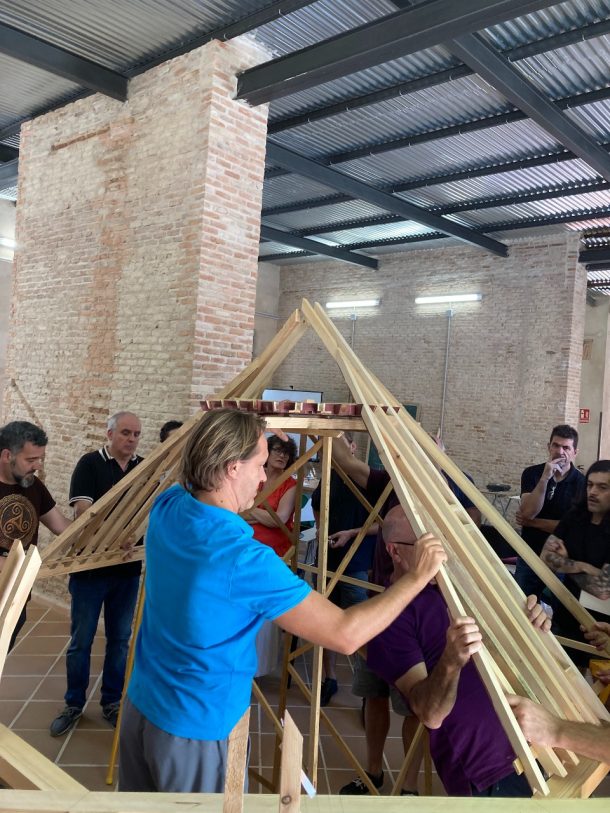
We worked on cutting the top of the pares (beams) for the different faldones (panel sections, literally ‘large skirts’), and considered the reconstruction of the model of the Salón Rico in Toledo. This is an important structure currently under renovation.
We then enjoyed an evening visit to the Casa de Mesa, a historic site that is under renovation, with two important ceilings being looked after by Javier and Enrique Nuere. Its massive, early seven-panel rectangular roof was really fascinating to see, and will be spectacular when restoration is finally finished. In the evening we went to Toledo’s Círculo de Arte, a bar and concert venue in a decommissioned church, which also has an amazing roof.

Day 5
We had a lecture by Enrique Nuere, architect and historic carpentry expert, and had our photos taken by the local Toledo press.
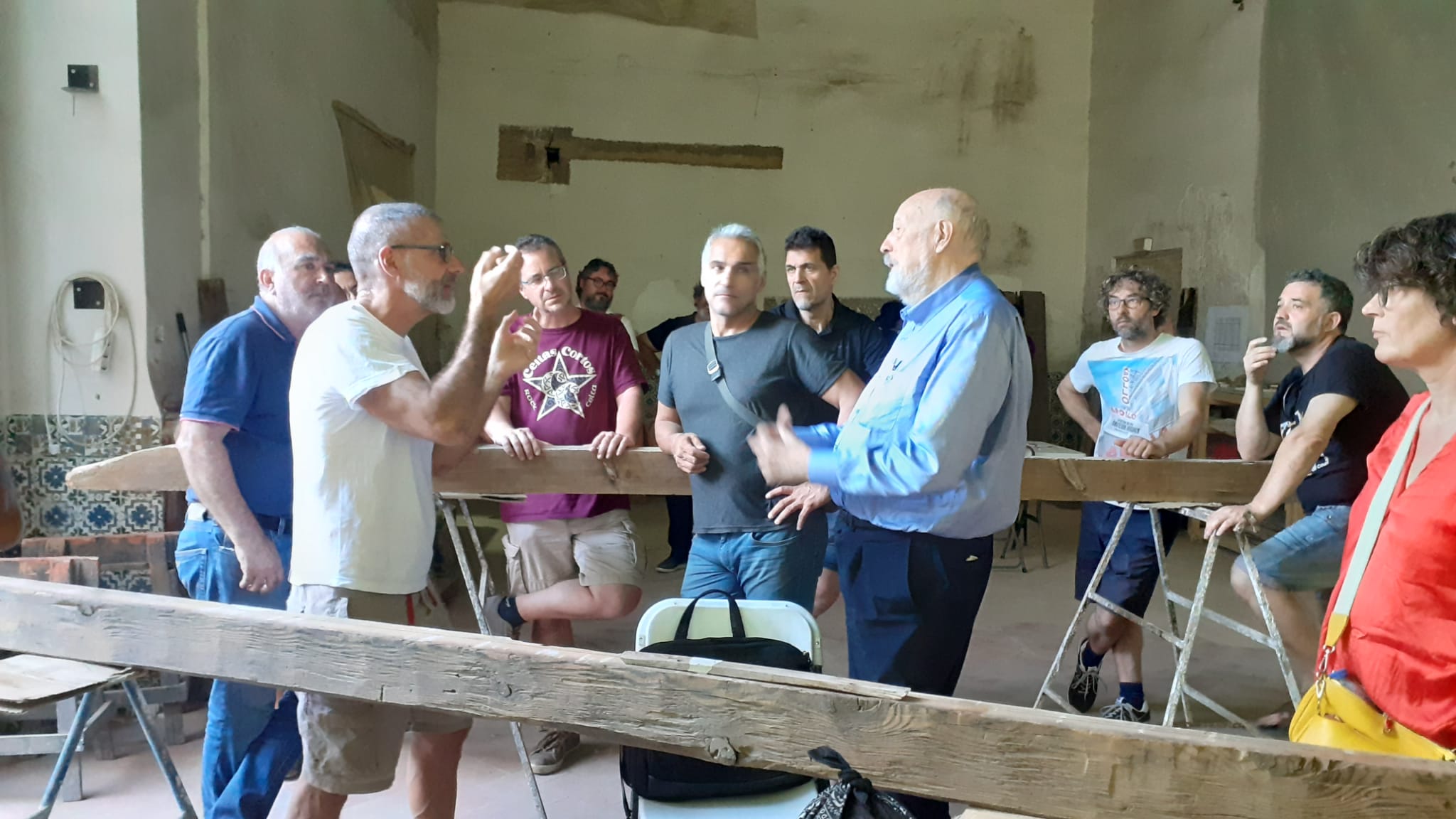
We walked up to the Salón Rico and talked about its refurbishment. We climbed up special scaffolding that was set up for us – it was amazing to see the Salón Rico up close. It was interesting to see the mistakes made in the refurbishment done 15 years ago and to speak with the carpenter who had done this, who was on the course with me. He was quite happy to say how little he knew about what he was doing at the time, but that he was so delighted to finally be on a course to learn how to do things properly – a shame he’s just retired!
Huge thanks to the Consorcio de Toledo for arranging this course and for opening it to the general public, and to Ángel, Javier and Enrique for their patience and expertise. I learnt a huge amount in this intense and fascinating week. I’m not sure I could build a medieval strapwork carpentry ceiling like those from the Torrijos palace, but it’s a start!


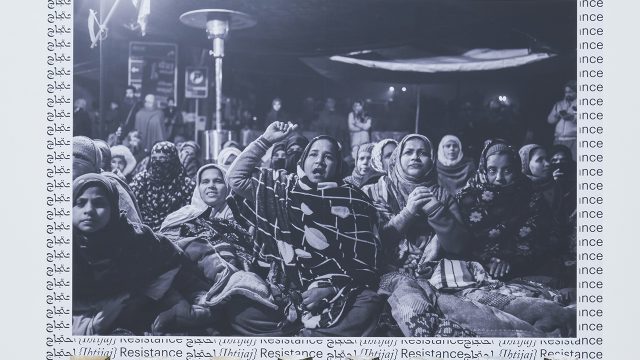

Very interesting and engaging description of the workshop. So important that the skills are preserved and understood, thanks